
Multisexual
(also: plurisexuality)

Table of Contents
- Introduction
- Multisexual (General Information)
- Bisexual
- Biromantic
- Omnisexual
- Pansexual
- Panromantic
- Polysexual
- Multisexual Resources
- Bisexual Resources
- Biromantic Resources
- Pansexual Resources
- Panromantic Resources
- Polysexual Resources
- See Also

Introduction
While sexuality is most commonly experienced as attraction to a specific gender, there are various terms that are used as self-descriptors by those who experience attraction to more than one gender. Most sexualities have corresponding romantic orientations. Not everyone who identifies as a particular sexuality will identify as the corresponding romantic orientation that you may think they should.
Every individual person has their own combination of experiences, and moves through the world in their own unique manner. Sexuality, romantic orientation, gender expression, gender identity, gender presentation, and transition goals will all look different for every individual person. These distinctions do not matter to everyone who experiences deviations from the norm, though they do matter significantly to some.
The distinctions that will be discussed throughout this particular page will be regarding sexual and romantic attraction to more than one gender. Some people who have attatchments to certain queer subcultures may identify as both a multisexual label and a traditionally monosexual label. Some people with particular preferences for certain genders will also choose to identify as both a multisexual label and a traditionally monosexual label. Some people - either questioning, indecisive, or simply hoarding labels for the fun of it - will identify as numerous seemingly contradictory terms. This harms no one.
If you come across any terms, acronyms, phrases, etc with meanings of which you are unsure, please consult the alphabet menu buttons at the top and bottom of this page to navigate your way to a relevant definition. Clicking on underligned things throughout the main text of this page will bring you to a relevant section of this site. If you have any feedback to provide, please click here.
Click to return to table of contents.

Multisexual (General Information)
Someone who is multisexual is attracted to more than one gender.
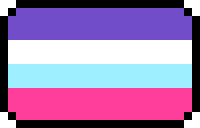
Click to return to table of contents.

Bisexual
Someone who is bisexual experiences sexual attraction to more than one gender.
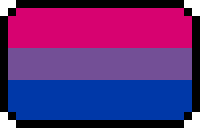
The pink stripe in the bisexual flag represents same-gender attraction.
The purple stripe in the bisexual flag represents attraction towards two or more genders.
The blue stripe in the bisexual flag represents attraction to those who are a different gender than yourself.
Click to jump to external links regarding bisexuality.
Click to return to table of contents.

Biromantic
Someone who is biromantic experiences romantic attraction to more than one gender.

The biromantic flag is similar to the bisexual flag, except it has a heart at the center.
Click to return to table of contents.

Omnisexual
Attraction to all genders.
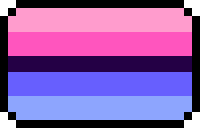
Click to return to table of contents.

Pansexual
Experiencing sexual attraction to more than one gender.
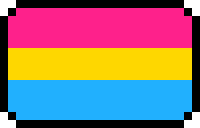
The magenta stripe in the pansexual flag represents attraction to people who identify as female.
The yellow stripe in the pansexual flag represents attraction to genders outside the traditional binary.
The blue (or cyan) stripe in the pansexual flag represents attraction to people who identify as male.
Click to return to table of contents.

Panromantic
Experiencing romantic attraction to more than one gender.
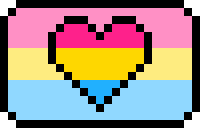
The panromantic flag is similar to the pansexual flag, except it has a heart at the center.
Click to return to table of contents.

Polysexual

Click to return to table of contents.

External Links

Multisexual Resources
- Lexicon Libary LGBT - Multisexual (https://lexicon.library.lgbt/definitions/multisexual/)
- LGBTQIA - Fandom - Wiki - Multisexual (https://lgbtqia.fandom.com/wiki/Multisexual)
- LGBTQIA - Wiki - Multisexual (https://lgbtqia.wiki/wiki/Multisexual)
- The Trevor Project: 04/23/2021: Multisexual Youth Mental Health: Risk and Protective Factors for Bisexual, Pansexual, and Queer Youth Who are Attracted to More than One Gender (https://www.thetrevorproject.org/research-briefs/multisexual-youth-mental-health-risk-and-protective-factors-for-bisexual-pansexual-and-queer-youth-who-are-attracted-to-more-than-one-gender/)
- Wikipedia - Plurisexuality (https://en.wikipedia.org/wiki/Plurisexuality)

Bisexual Resources
- American Psychological Association - Understanding Bisexuality (https://www.apa.org/pi/lgbt/resources/bisexual)
- Anything That Moves (https://anythingthatmovesarchive.carrd.co/) - online archive of Anything That Moves, the 1990s-2000s bisexual magazine
- Bialogue - Bi Definition (http://www.bialogue.org/Pages/BiDefinition.html)
- bi.org (https://bi.org/en)
- Bisexual Index (http://www.bisexualindex.org.uk/index.php/Main/HomePage)
- Healthline - What Does It Mean to Be Bi or Bisexual? (https://www.healthline.com/health/what-is-bisexual)
- Human Rights Campaign - Bisexual FAQ (https://www.hrc.org/resources/bisexual-faq)
- LGBTQIA - Fandom - Wiki - Bisexual (https://lgbtqia.fandom.com/wiki/Bisexual)
- Merriam Webster Dictionary - Bisexual (https://www.merriam-webster.com/dictionary/bisexual)
- Orientation - Fandom - Wiki - Bisexual (https://orientation.fandom.com/wiki/Bisexual)
- Queer Books for Teens - Bisexual (https://queerbooksforteens.com/find-books/?fwp_orientation=bisexual) - list of books with bisexual characters
- Queerdom - Fandom - Wiki - Bisexual (https://queerdom.fandom.com/wiki/Bisexual)
- Queer in the World: Cecilia Miller: 10/14/2023: What Exactly Is The Bisexual Pride Flag, And What Does It Mean? (https://queerintheworld.com/bisexual-pride-flag/)
- The Bisexual Manifesto (https://bimanifesto.carrd.co/)
- The Trevor Project - Understanding Bisexuality (https://www.thetrevorproject.org/resources/article/understanding-bisexuality/)
- Trans Language Primer - Bisexual (https://translanguageprimer.com/bisexual/)
- Wayback Machine: Bisexual Resource Center: what is bisexuality? (https://web.archive.org/web/20200511114330/https://www.biresource.net/whatis.shtml)
- Wayback Machine: UIC: COMMON MYTHS OF BISEXUALITY (https://web.archive.org/web/20151108082558/https://www.uic.edu/depts/quic/bisandallies/myths.html) - the earliest archive for this link is 05/03/2001 so it is at least that old
- Wikipedia - Bisexual Flag (https://en.wikipedia.org/wiki/Bisexual_flag)
- Wikipedia - Bisexuality (https://en.wikipedia.org/wiki/Bisexuality)
Click to return to table of contents.

Biromantic Resources
- LGBTQIA - Fandom - Wiki - Biromantic (https://lgbtqia.fandom.com/wiki/Biromantic)
- Orientation - Fandom - Wiki - Biromantic (https://orientation.fandom.com/wiki/Biromantic)
- Pink News: Michele Theil: 01/31/2024: Biromanticism explained – including how it differs from bisexuality (https://www.thepinknews.com/2024/01/31/what-does-biromantic-mean/)
- Pop Sugar: Taylor Andrews: 06/13/2022: What Does It Mean to Be Biromantic? (https://www.popsugar.com/fitness/biromantic-meaning-48856112)
- Queer Books for Teens - Biromantic (https://queerbooksforteens.com/find-books/?fwp_romantic=biromantic) - list of books with biromantic characters
- Queerdom - Fandom - Wiki - Biromantic (https://queerdom.fandom.com/wiki/Biromantic)
- The Pleasant Relationship: Julianne Cantarella, MSW, LSW: 07/13/2022: Biromantic: What Does It Mean? [Definition, History, Signs, and Everything Else] (https://thepleasantrelationship.com/biromantic/)
- Very Well Mind: Toketemu Ohwovoriole: 08/14/2024:8 Signs You May Be Biromantic (https://www.verywellmind.com/8-signs-you-may-be-biromantic-8663152)
Click to return to table of contents.

Pansexual Resources
- Britannica: Alison Eldridge: 04/01/2025: Pansexuality (https://www.britannica.com/topic/pansexuality)
- Everyday Feminism: Kaylee Jakubowski: 11/12/2014: Pansexuality 101: It’s More Than ‘Just Another Letter’ (https://everydayfeminism.com/2014/11/pansexuality-101/)
- Good Good Good: Kamrin Baker: 01/04/2024: What Is the Pansexual Pride Flag & What Does It Mean? (https://www.goodgoodgood.co/articles/pansexual-pride-flag)
- Healthline: E. Mimi Arquilla, DO & Gabrielle Kassel: 07/01/2021: How Do You Know If You’re Pansexual? (https://www.healthline.com/health/pansexual)
- LGBTQIA - Fandom - Wiki - Pansexual (https://lgbtqia.fandom.com/wiki/Pansexual)
- MedicalNewsToday: E. Mimi Arquilla, DO & Lorenzo Lucchetti: 07/27/2023: Pansexuality, what it means, and myths (https://www.medicalnewstoday.com/articles/pansexual)
- Merriam Webster Dictionary - Pansexual (https://www.merriam-webster.com/dictionary/pansexual)
- Orientation - Fandom - Wiki - Pansexual (https://orientation.fandom.com/wiki/Pansexual)
- Queer Books for Teens - Pansexual (https://queerbooksforteens.com/find-books/?fwp_orientation=pansexual) - list of books with pansexual characters
- Queerdom - Fandom - Wiki - Pansexual (https://queerdom.fandom.com/wiki/Pansexual)
- Trans Language Primer - Pansexual (https://translanguageprimer.com/pansexual/)
- Wayback Machine: Stop Homophobia: 2013: What is Pansexual? (https://web.archive.org/web/20190423082006/https://www.stop-homophobia.com/pansexuality.htm)
- Wayback Machine: shitrichcollegekidssay: 06/27/2014: Anonymous asked: What is the difference between polysexual and bisexual? I identify as poly but I've been told off for not using bi. (https://web.archive.org/web/20161110230233/https://shitrichcollegekidssay.tumblr.com/post/90036438984/what-is-the-difference-between-polysexual-and)
- Wikipedia - Pansexual Flag (https://en.wikipedia.org/wiki/Pansexual_flag)
- Wikipedia - Pansexuality (https://en.wikipedia.org/wiki/Pansexuality)
Click to return to table of contents.

Panromantic Resources
- LGBTQIA - Fandom - Wiki - Panromantic (https://lgbtqia.fandom.com/wiki/Panromantic)
- Orientation - Fandom - Wiki - Panromantic (https://orientation.fandom.com/wiki/Panromantic)
- Queer Books for Teens - Panromantic (https://queerbooksforteens.com/find-books/?fwp_romantic=panromantic) - list of books with panromantic characters
- Queerdom - Fandom - Wiki - Panromantic (https://queerdom.fandom.com/wiki/Panromantic)
Click to return to table of contents.

Polysexual Resources
Click to return to table of contents.

See also the pages for; monosexual, sexuality, multigender.

